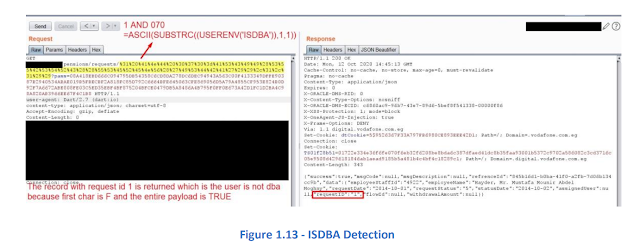Interesting Blind Boolean SQL Injection in a Private Bug Bounty Program
The application is vulnerable to Blind Boolean SQL Injection vulnerability
which relies on sending a SQL query to the database which forces the
application to return a different result depending on whether the query returns
a TRUE or FALSE result. Depending on the result, the content within the HTTP
response will change, or remain the same. This allows an attacker to infer if
the payload used returned true or false, even though no data from the database
is returned.
Impact:
An attacker may execute arbitrary SQL
statements on the application databases. This may compromise the
integrity of the database and expose sensitive information.
Root-Cause:
The SQL injection occurs because the application accepts user input that is directly placed into SQL statements and doesn't properly filter out dangerous characters. SQL injection can lead to disclosing data stored in the database tables. All URLs containing the requestID, flowId and timesheetID URI parameters are vulnerable.
Examples as below:
|
Examples of Vulnerable APIs |
|
/medicalcards/requests/{requestID} /medicalcards/requests/flowids/{flowId} /phoneprograms/requests/{requestId} /installments/requests/{requestID} /pensions/requests/{requestId} /timesheets/requests/{timeSheetId}
|
Manual
Detection and Verification:
All vulnerable parameters are allowing
only numeric values and some Boolean keywords ex: AND/OR which is evaluated in the server-side database queries
and in the end it should return numeric value to retrieve the existing request
from the database so, this allowed us to know if the payload used returned true
or false even though no data from the database is returned.
·
AND/OR Detection:
·
URL-Encoding
Detection:
At this stage we detected and confirmed
that the application is vulnerable to SQLi and the back-end database is ORACLE because the concat operator (||)
but the problem was that the only allowed keywords was only AND/OR and as
mentioned before it should return only numeric value. So, we managed to bypass these
limitations by URL-Encoding our
payload using other keywords and built-in functions that should return only
numeric values such as SUBSTR,USERENV('SID'),USERENV('SESSIONID'),
UID. So, these numeric values will be placed as a number in the requestID sql
query in the back-end.
Injected
Payload:
%31%20%4f%52%20%34%34%34%34%3d%53%55%42%53%54%52%28%27%34%34%34%34%34%27%2c%20%31%2c%20%34%29
The payload is 1
OR 4444=SUBSTR('44444', 1, 4) and
shown in the screenshot below:
USERENV and built-in functions return
information about the current session:
·
Building Strings:
At this stage we were able to inject
string values in the vulnerable parameters using (URL-Encoding). So, we have to
build our payloads using other SQL keywords to able to retrieve information
from the database. Each DBMS provides its functions for doing this such as
ASCII,UNHEX,CHAR,HEX,ORD are useful to translate strings to numbers or numbers
to strings.
We used the ASCII() function to return the ASCII value for the specific
character as shown below. Our payload executed successfully and returned the ASCII
value and then retrieved the request id with this value. ASCII('t') is equal to 116.
Here is an example to know if the
current database user is DBA or not by using USERENV('ISDBA') built-in function
which returns TRUE or FALSE, so we have to convert the first character to its
ASCII number value to detect the result:
Injected
Payload:
%31%20%41%4e%44%20%30%37%30%3d%41%53%43%49%49%28%53%55%42%53%54%52%43%28%28%55%53%45%52%45%4e%56%28%27%49%53%44%42%41%27%29%29%2c%31%2c%31%29%29
Which is: 1 AND 070=ASCII(SUBSTRC((USERENV('ISDBA')),1,1)) -> 070 is the first
letter and equal (F)
·
Exploit Automation
With SQLMap:
In order to exploit the vulnerability,
we had to modify SQLMap to obfuscate the payload with aggressive URL-Encoding
to encode every character.
We have modified the
"between" tamper script that (replaces greater than operator (>)
with NOT BETWEEN 0 AND # and equals operator (=) with BETWEEN # AND #) and to
encode all the payload by adding the following two line of codes:
Then, we used SQLMap tamper option in order to have it use
our custom script on its payload pre-injection. The vulnerability allowed us to
gain access to the applications database. Below is a sample of the data we
retrieved:
SQLMap
Command and Explanation:
python.exe sqlmap.py -r vodafoner.txt
--auth-type="Digest" --auth-cred="redacted:redacted"
--proxy=https://192.168.1.13:443 --timeout=600 --technique=b
--tamper="between2" -v 5 --dbms=Oracle --string="requestID"
--risk=3 --level=5 --current-user
1. Get Current-User:
2. Get Oracle Version:




















No comments:
Post a Comment